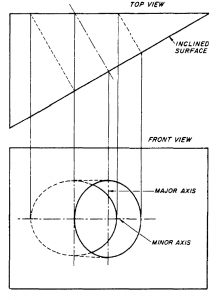A circle on a surface that is parallel to the plane of projection will project as a circle. A circle on a surface that is oblique to the plane of projection, however, will project as an ellipse, as shown in figure 5-21.

The upper view in this figure is a top view of a wedge, the wedge having a hole bored through it perpendicular to the inclined face. The outline of this hole on the front face of the wedge projects as an ellipse in the front view. You get the minor axis of the ellipse by projecting downward as shown. The length of the major axis is equal to the diameter of the hole. Another ellipse is shown in the front view.
This is the partly hidden and partly visible outline of the hole as it emerges through the back of the wedge. The back of the wedge is parallel to the front view plane of projection; therefore, this ellipse is the true outline of the hole on the back of the wedge. The outline is elliptical because the hole, though it is circular, is bored obliquely to the back face of the wedge.
